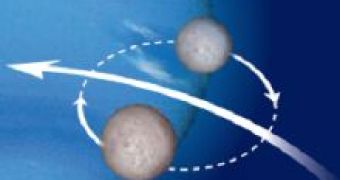One of the biggest mysteries of our solar system may have been solved: how Neptune's largest moon, Triton, was captured by the giant planet. Triton is the most unusual moon in the solar system - not only that it is huge, around 40% larger than Pluto, but it orbits Neptune in the opposite direction to Neptune itself - a so-called "retrograde" orbit. Triton also has such an inclined axis that it seems to be orbiting Neptune like a wheel. This facts show that Triton couldn't have originally formed as a satellite of Neptune, but it must have been captured by Neptune at a later time.
Craig Agnor of the University of California at Santa Cruz and Douglas Hamilton at the University of Maryland now argue in a paper published by Nature that Triton may once have been part of a binary system that got too close to Neptune. One of the bodies was cast away into space in a slingshot effect while the other, Triton, became gravitationally bound to the giant planet as it is today.
Over the years, scientists had proposed many explanations for the capture of Triton, but no theory managed to hold up under close scrutiny. Some proposed a "gas-drag" effect, assuming Neptune's atmosphere used to be much more extensive than it is today and this slowed Triton down enough for it to be captured. Others proposed the idea that Triton may have collided with another satellite near Neptune, causing it to slow down and be captured.
Agnor and Hamilton have proposed another capture mechanism involving the encounter between a binary system and a planet. Astronomers have seen similar three-body encounters between a black hole and a binary system of stars - but now it is proposed that this can also happen at much smaller scales - that of planets and moons.
The physicists proposed that Triton was originally part of a pair of bodies orbiting the Sun in the early solar system - maybe the way Pluto and Charon system is today. But Neptune's gravity pulled Triton away from its companion when the duo happened to venture too close to the giant gas planet.
This new theory is inspired by the recent discovery of many binary systems of objects in the Kuiper belt - the area of the solar system beyond Neptune. Scientists say that up to 15% of Kuiper-belt objects are binaries. The original binary system of which Triton had been a part of probably was also among the Kuiper-belt objects.
"We've found a likely solution to the long-standing problem of how Triton arrived in its peculiar orbit," says Agnor. "In addition, this mechanism introduces a new pathway for the capture of satellites by planets that may be relevant to other objects in the solar system."
Image credit: A Morbidelli

 14 DAY TRIAL //
14 DAY TRIAL //